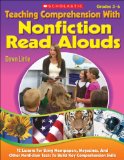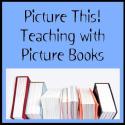Today’s guest post is by Amy Mascott of teachmama. On her blog, Amy shares how she tries to sneak in some sort of learning for her own children in the every day. Nothing super-fancy, expensive, or complicated–just learning through meaningful time and play together.
Predicting is one of the easiest comprehension strategies to use with emerging readers, and like many of these important components of early literacy, predicting can be taught even before children can read on their own.
Today, while Owen, Cora, and I took a break from watching our electrician make sense of some aging and finicky outlets, we picked up a book I ordered a few weeks ago but had not yet read with the kiddos.
 It is written by an author we all adore–Karma Wilson–and the title itself had me wondering what on earth would make our poor, beloved bear feel scared.
It is written by an author we all adore–Karma Wilson–and the title itself had me wondering what on earth would make our poor, beloved bear feel scared.
It happens to be another masterpiece, full of rich language spun through a strong story, and it was perfect to work on predicting.
- Predicting: Predicting, as a reading strategy, is actually just using pictures or text to make a guess about what will happen in piece of literature. Even our little ones can do this by looking at the cover of a book, the illustrations on a page, or hearing the title or story read aloud.
We began by looking at the cover of Bear Feels Scared and by talking about what we saw:
I said, This is a new Bear book for us, and the title is ‘Bear Feels Scared’. I wonder what Bear is afraid of. Hmmmm. Look at the cover. What do you see?
Owen mentioned that there were things in front of Bear’s face, like maybe rain or snow. He also said, It doesn’t look like it’s sunny out.
You’re right, Owen. It doesn’t look like it’s a warm and sunny day, does it? Cora, what time of day does it look like it is for Bear and his friends? What do you think?
Cora said, Maybe night-night time for them? (Woo-hoo!)
Yep, I think you’re right. It’s dark, it’s rainy and windy, and some of Bear’s friends have worried faces. What might make Bear feel scared in this book? Can you make a prediction? A prediction just means you’re making a guess about something.
Owen said, Maybe Bear is afraid of the dark.
Cora added, He thinks there’s a monster in his room. (Oh my gosh–maybe this is why Cora’s been up waaaay too late recently?! Maybe this is why she’s been so cranky? Note to self: tackle monster topic asap.)
You both made some really good predictions; Bear may be afraid of the dark, and maybe he does think there’s a monster in his room. Let’s read and find out.
About mid-way through the story, we chatted about their predictions; we confirmed that it was indeed nighttime, and we learned that what made Bear feel scared was that he was lost and lonely in the dark and he wanted to be home with his friends. Yeah for Owen and Cora! They learned about predicting!
As I read the story, we chatted about the author’s diction, or word choice:
–What does it mean when the ‘sun starts to set‘?
-If I ‘mutter‘ something, I might say it like. . .
-When Bear ‘sheds big tears‘, what is he doing?
-Aaaaahhhhh, I just ‘sighed a big sigh‘. Let me hear you both sigh a big sigh.
-Later, when Maddy asked me to read it to her before bed, we chatted about other words: ‘lumber’, ‘flounce’, ‘trudge’, and ‘cluster’.
Ms. Wilson throws in so many super words here, it’s hard to let them go with an initial reading, but for us, the ‘Bear’ books are read and re-read, so it’s easy–and better for little brains–to focus on just two or three things per reading so as not to lose the rhythm of the language or overall storyline.
I’ve had predicting on the brain ever since I read an article in this month’s Reading Teacher, a chapter from Liang and Galda’s Children’s Literature in the Reading Program, 3rd ed. The chapter actually focused on ways to combine response activities and comprehension strategies to enhance students’ engagement–and appreciation–of texts. It was really interesting and is worth checking out. The focus on responding and practicing predicting was actually with upper elementary students but also mentioned were some cool ways of using responding and practicing visualizing for the younger readers. I hope to try them out soon.
Liang and Giada say that “predicting is easy to teach and is an easy strategy for students to learn” and that “it is also a strategy that research shows to be quite powerful in helping students better understand a text.”
Predicting–try it today because:
- it can be used with just about anything, including just about any decent children’s book;
- it gets kiddos thinking (woo-hoo!);
- it keeps them engaged in the text because they wonder if what they think will happen actually will (they’ll feel like little detectives!);
- it will help them to remember what they’ve read;
- if we start modeling–and practicing–these reading strategies now, with our little ones, our kiddos will become adept at doing these kind of things on their own as they become stronger readers;
- soon predicting will be just another natural reading activity that our kids will do unconsciously, which will make them better readers and thinkers. (seriously!)
And that was our sneaky learning for today. Thanks, Bear!
Thanks, Karma Wilson! One last thing that makes me feel like I want to hug Karma Wilson and be her BFF–not only because she, too, is a mama of three and writes books I could only dream of writing myself–but her website totally rocks. Tons of resources for parents, cool activities to use in conjunction with many of her books, pictures of her adorable family, links to her blog and Twitter name, and it’s just plain gorgeous.
Amy Mascott, a Reading Specialist and High School English teacher, is also the creator of we teach, a forum for parents and teachers to share, learn, and grow.







